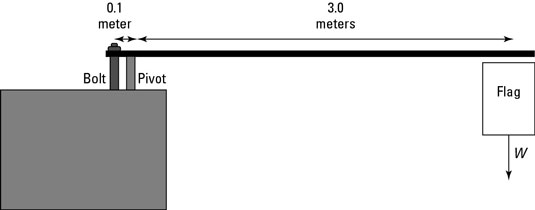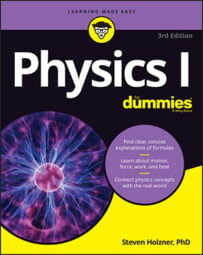You can use physics to calculate the amount of force needed to offset torque and maintain rotational equilibrium. For example, say the manager at the hardware store you work at asks you to help hang a flag over the top of the store. The store is extra-proud of the flag because it’s an extra-big one (to check it out, see the figure). The problem is that the bolt holding the flagpole in place seems to break all the time, and both the flag and pole go hurtling over the edge of the building, which doesn’t help the store’s image.

To find out how much force the bolt needs to provide, you start taking measurements and note that the flag has a mass of 50 kilograms — much more than the mass of the pole, so you can neglect that. The manager had previously hung the flag 3.0 meters from the pivot point, and the bolt is 10 centimeters from the pivot point. To get rotational equilibrium, you need to have zero net torque:
where net torque is represented by the Greek letter tau. In other words, if the torque due to the flag is
and the torque due to the bolt is
then the following is true:
What are the torques involved here? The direction of all the torque vectors is perpendicular to the plane of the figure, so consider only the component of these vectors in that direction (a positive component would correspond to a counterclockwise rotational force in the figure, and a negative component would correspond to a clockwise rotational force). Because you’re dealing with the components of the vector, which are numbers (not directions), you don’t write them in bold type. You know that the flag’s weight provides a torque
around the pivot point, where
where m is the mass of the pole, g is the acceleration due to gravity, and l1 is the lever arm for the flag. Plugging in the numbers gives you the following:
Note that this is a negative torque because g is negative, and the lever arm is positive, to the right — the force causes a clockwise turning force, as the preceding figure shows.

Plugging in as many numbers as you know gives you
The lever arm is positive because the bolt provides a counterclockwise turning force (or mathematically, the angle between the force and the lever is theta = 90 degrees), so
Because you want rotational equilibrium, the following condition must hold:
In other words, the torques must balance out, so
Now you can finally find F2, because you know both
and l. Plug the known values into the equation
and solve for F2:
Putting F2 on one side and solving the equation gives you

The bolt needs to provide at least 14,700 newtons of force, or about 330 pounds.

